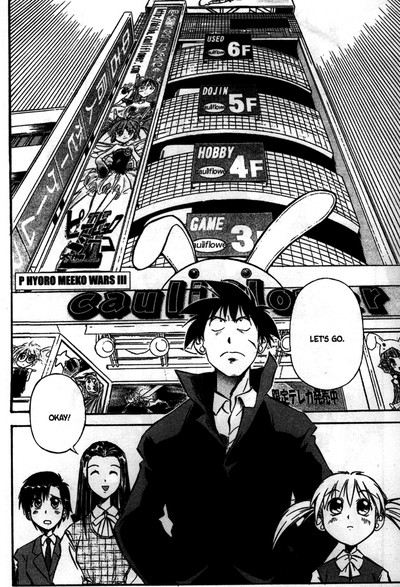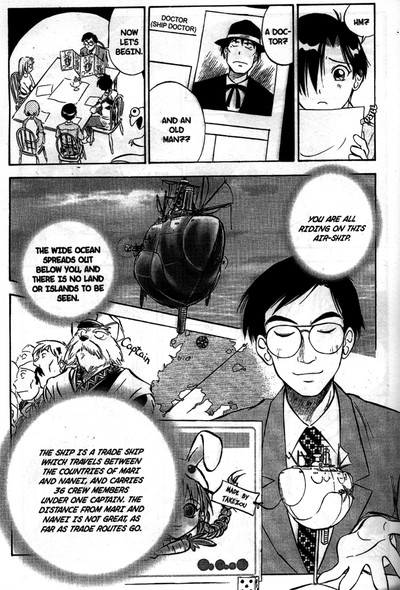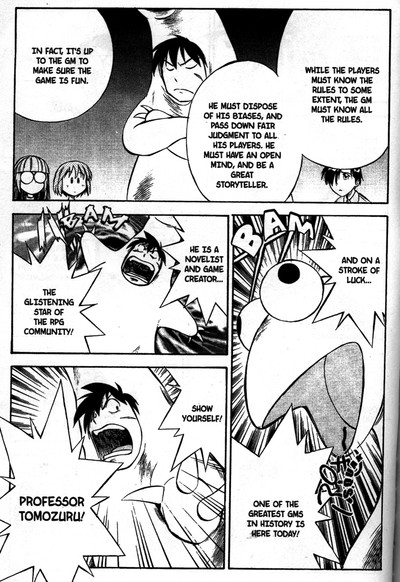Jason Thompson's House of 1000 Manga - Maniac Road
by Jason Thompson,
Episode XX: Maniac Road
"I'm so depressed! Yet another local model shop went out of business the other day!"
—Shinsuke Kurihashi

My dad is an otaku. Not for manga, anime or video games, though: he is an otaku for model trains. When I was a little kid, he would spend several weekends a year at model train conventions, taking my mom, my brother and sister along and leaving us to entertain ourselves in the hotel pool while he geeked out with other middle-aged men about O-scale locomotives. Every year at Christmas, he would give out model trains as gifts, and set up train displays, to try to turn the younger generation into model train aficionados. It never worked, of course – who wants to have the same hobbies as your dad? -- although I did enjoy some of the old science fiction novels he loaned me.
Shinsuke Kurihashi's Maniac Road is one of the thousands of
"up with otaku!" geekfests set in Akihabara, the famous Tokyo nerd neighborhood. Originally a postwar electronics merchandise district before it became enshrined as the world's greatest place to buy dojinshi, moe body pillows and eroge, Akihabara shows up in more anime and manga than any other place I can think of. The only interesting way left to use Akihabara would be in a story about the Shinto shrine built there in 1870 (thanks Wikipedia!), or about some non-nerdy people who live in the neighborhood but have absolutely no interest in manga and anime. Like I, Otaku - Struggle in Akihabara, Maniac Road is a story of outwardly normal people who are converted into otakuhood, and like all such manga, it has a checklist of things it must include:
(1) a scene at Comic Market (under some thinly fictionalized name)
(2) a scene in which otaku ask a girl to cosplay for them
(3) a joke about yaoi (to show they're not sexist, honest)
(4) a character who talks about how much they hate otaku but who is an otaku deep down
(5) either a blissfully cheerful attitude towards the dirty side of fandom, like Genshiken, or the attitude that otaku are morally pure saints who would never, ever, ever build a model figure, buy a dojinshi or take a cosplay photograph for impure purposes (this is one reason I like Dojin Work; it's honest in its smuttiness).
Takezou Muto is a homeless nerd of indeterminate age who collapses on the street in Akihabara while looking for a pre-release copy of "P Hyoro Meeko Wars III." The hapless drifter is found in the garbage and nursed to health by three sisters who run an electronic store; mature-woman housekeeper type Haruna, rebellious high school girl Aoba, and cute, teeny-tiny video game prodigy Isuzu. Sadly, their family electronics store is on the verge of bankruptcy, suffering from competition with unscrupulous rivals and the big new geek store on the block, Cauliflower (a parody of guess which chain of otaku megastores?). To pay back the sisters for their hospitality, Takezou promises to help them with their marketing and inventory and turn their store into the awesomest nerd store in all of Akihabara.
Aoba, the middle sister (the "I hate otaku" type), is annoyed by Takezou's presence in their home, since he is a ragged and apparently stinky otaku. (It's established that he smells bad – although as Takezou says, "Don't be such a prude! The way modern day people worry about odors is just an obsessive compulsive disorder!") But the older sister and the younger sister like him, and so Takezou ends up living with them and working hard to make the store a success. In each chapter, Takezou tries a new way to help out the store, which usually involves rubbing Aoba's nose in some obscure aspect of otaku culture and getting her to grudgingly admit that she likes it. In the process, he talks a bit about how to run a business, and shows us some example of how the heartwarming power of the otaku can overcome various problems, such as what to do when your boss fires you because you punched your coworkers because they messed with the Dollfies you keep at your desk. (The answer: show your boss how fun it is to make dolls, so that soon, he will be shopping at Maniac Road for doll outfits.)
Takezou is a blank slate character, an otaku too perfect to be real, despite his smell problem. He's tall, skinny and weary-looking, but he still has the fiery passion of a shonen manga character, getting passionate about dolls and model kits, shouting his barbaric yawp of nerd rage over the roofs of the world. The scar on his face, we eventually discover, was inflicted by his father when Takezou revealed that he was an otaku, a terrible price to pay for coming out. Throughout the manga, there are hints of romantic tension between Takezou and the older two sisters. Basically, Takezou has a crush on Haruna, and Aoba has a crush on…well, who else is there to have a crush on? As for elementary-school-age Isuzu, Takezou calls her "loliloli," but thankfully he doesn't hit on her. Mikasa, the handsome president of Cauliflower corporation (damn those suave millionaires with their Di Gi Charat money!!), also likes Haruna and tries to interfere with their relationship like Coach Mitaka to Takezou's Godai. There isn't much sex: the kinkiest thing in it are a few obligatory breast jokes, and is a few girls with unicorn horns on their foreheads (which always makes me think of one thing, and it isn't unicorns).

But romance and fanservice are not the point here: nerdiness is. The best point of Maniac Road, beneath its bland art and its not exactly page-turning story, is that you really get the sense of Shinsuke Kurihashi's personal flavor of nerd. Kurihashi is an obscure artist who drew just a few manga for ASCII Media Works' otaku magazines like Dengeki Daioh. In his self-portraits, he disturbingly draws himself as a frazzled head sticking out of something that looks like a hairy potato, or possibly a set of testicles. Someone at ComicsOne/DrMaster must have liked him, because they published several of his manga: Infinite Ryvius (an adaptation of the anime series), Maniac Road, and its sequel, Pretty Maniacs . Main character Takezou is probably a self-insertion character by Kurihashi, and Kurihashi/Takezou's interests are obscure and weird. Although Maniac Road was published in 2002, its cultural antenna is set way, way earlier, into stuff which was most popular in the 1980s, and not even very popular then. Even the title indicates that Maniac Road is the work of an older fan: the word "mania" (the literal translation of the Japanese title) was the self-chosen appellation of old-school Japanese nerds who didn't like the word "otaku," before a later generation embraced it. In short, Maniac Road isn't some manga which uses maids and yaoi jokes and moe in a cheap attempt to be popular; instead, an aging nerd's tribute to the things he loves.
THINGS KURIHASHI LOVES #1: MILITARY MODEL KITS. Kurihashi loves model kits. I personally never had the patience for them, but Kurihashi sings the praises of spending hours in your workshop with tweezers and glue to construct super-detailed pieces of military equipment. Oh, and not robots either: real military equipment, like a 1/700 scale model of the Nagato battleship from World War II! Battleships are so important to Kurihashi that the three sisters, Haruna, Isuzu and Aoba, are named after battleships. Kurihashi jumps into this deep hard-core nerdiness right in the very first chapter, proving that he's just as much of a military nut as Kensuke Aida from Evangelion. The plot of one particularly weird chapter even involves two Japanese WWII vets who never surrendered and are still hiding out in a cave with a special secret WWII submarine. (They, of course, are otaku after a fashion.)
But what about those who would say that all of this is an unhealthy glamorization of war, and that Kurihashi is probably some right-wing military freak? Takezou's answer: "Some say that we love fighting, or that we romanticize war! This is a stereotype, and completely wrong! True battleship enthusiasts hate wars! When a war happens, these beautiful works of art are demolished!" Well, if you say so. When Takezou puts a bunch of battleships on display in the store, an American veteran even shows up to examine the craftsmanship. He runs into a Japanese WWII vet. "I manned this lookout," reminisces the Japanese guy. "I served on this ship," muses the American. They turn to each other in a moment of tension and then join in a manly hug, tears running down their eyes. WORLD WAR II GAR!
THINGS KURIHASHI LOVES #2: PAINTBALL. In another chapter, Kurihashi convinces the girls to join him in a paintball game with his paramilitary-looking buddies out in the wilderness. Aoba, the perpetual thrill-killer, is skeptical and thinks they're a bunch of dangerous militants. Takezou objects: "Those kinds of people are not true gun lovers! Air guns and model guns are made to safety standards several times that of real guns! Every time we hear the news that some stupid guy used the gun to harm, the gun cries!" In other words: airsoft guns don't kill people, people kill people! Isuzu, the chibi otaku, turns out to kick ass in airsoft combat.
THINGS KURIHASHI LOVES #3: WARGAMES. In yet another chapter, Takezou tells the young'uns about old-school military boardgames, like the kind that used to be made in America by Avalon Hill (although the example he uses is a Gundam game). My dad used to collect these games too: these super-complicated games with rules printed in 5 point type, games with cheap hexagonal boards and hundreds of paper chips for figures, games with titles like "Sinai" (yes – a board game about the 1967 Arab-Israeli war – I wish I was kidding) and "Franco-Prussian War" and "Nuclear War 1972". Takezou explains how military wargames came about, and how they eventually got replaced by videogames: "The rules became more and more difficult. Eventually it turned into more of a math drill than a game. In other words, the game's progress was a kind of death spiral of improvements…soon, these games were all made into video games, and the board game itself saw its demise."
So, yes…Shinsuke Kurihashi loves military geekery, and he proudly defends his fandom against the haters, presenting all this as being as pure and innocent as possible. I think this is at least a legit as Genshiken presenting porno dojin makers as being loveable, well-adjusted folks. Maniac Road also has chapters about non-military figure models, dollmaking, cosplay, the obligatory Comic Market chapter (in which dojinshi is translated as "amateur comic"), and tons of other stuff, but it's clear where Kurihashi's preferences lie. And therein lies another very personal reason why I like Maniac Road…
THINGS KURIHASHI LOVES #4: TABLETOP ROLEPLAYING GAMES.

Yes, in the 2nd volume of Maniac Road, Takezou decides out of the blue to introduce the sisters to the joys of Dungeons & Dragons style tabletop role-playing! As someone who liked pen-and-paper RPGs enough to write a graphic novel series about them, this chapter blew me away. You could even say it inspired me. In manga and anime, after all, the word "RPG" is usually synonymous with console RPGs. And even when tabletop RPGs are depicted, as briefly in Yu-Gi-Oh!, it's usually presented in the usual oversimplified viewpoint where the game master is the "bad guy" and the players are the "good guys." Not so in this manga, where Takezou gives this explanation of tabletop RPGing:
"A tabletop roleplaying game is a game made from the story created between the game master and the players. The Game Master creates varieties of possibilities to various scenarios, leads the players, and decides the outcome of their actions. He must have an open mind, and be a great storyteller. In fact, it's up to the GM to make sure the game is fun!"
If that doesn't make sense, well, I couldn't explain it any better. Takezou introduces the girls to his friend Professor Tomozuru, the "glistening star of the RPG community," one of the best GMs in Akihabara. Then the five of them sits down to play a tabletop RPG, in which they play characters against type (Aoba plays the Takezou-esque character and Takezou plays the cute girl) and must solve a mystery aboard an airship in a science fiction world. (It's not even the usual boring fantasy RPG setting.) Entertainingly, the game ends badly, with people dying and the GM admitting "Yeah, we kind of went in a bad direction." It's a cute sequence, and the most realistic portrayals of RPGs I've ever seen in a manga.
Earnestness is Maniac Road's greatest strength…but also its greatest weakness. The biggest problem with Maniac Road (apart from the aforementioned blandness) is that tries too hard to convince you of the awesomeness of cosplay, military model making, tabletop roleplaying, paintball and what have you. Takezou is obviously a mouthpiece of the author, and in every chapter he goes off on long speeches about why you should care about some old-ass fandom thing or why Thing X is awesome. There's no subtlety or distance from the subject. When I compare Maniac Road to Genshiken, which was published in the same year, Genshiken is cool because it doesn't try too hard, whereas Maniac Road overexplains everything with its frantic desperation to pass on these priceless gems of otaku culture before all the old nerds die off. It's the desperation of a nerd who really likes what he likes and wants you to like it too, but it comes off like listening to your parents tell you about how anime was back in the day. In the case of Maniac Road, less would have been more. (And yet, it isn't frantic and high-volume enough to turn into a self-parodying depiction of over-the-top fanaticism.)
Maniac Road was followed by a sequel, Pretty Maniacs, in which the otaku obsession of Takezou was continued by a new cast of three new cute girls. But Pretty Maniacs is just more of the same, and it feels less honest; to be blunt, it's like Kurihashi is making his middle-aged otaku sensibilities more palatable by speaking through the skins of young women. Deep down , the original Maniac Road is simple manga about a guy who really loves what he loves. Since I love some of those things too, I have a soft spot in my heart for it. Moving back to my dad for a second, I was shocked to discover that Maniac Road even has a two page spread about that most obscure of Japanese hobbies…model trains! Truly, it's like this manga was actually written by my dad. Maybe otakudom is genetic.
Jason Thompson is the author of Manga: The Complete Guide and King of RPGs, as well as manga editor for Otaku USA magazine.
Banner designed by Lanny Liu.
discuss this in the forum (14 posts) |